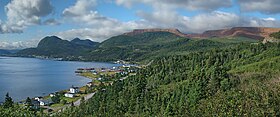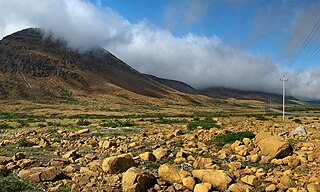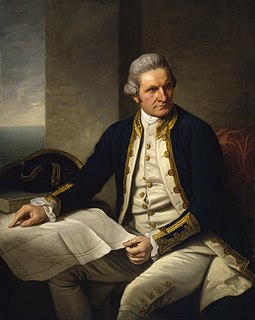
The Canary Islands is a Spanish archipelago and the southernmost autonomous community of Spain located in the Atlantic Ocean, 100 kilometres west of Morocco at the closest point. The Canary Islands, which are also known informally as the Canaries, are among the outermost regions (OMR) of the European Union proper. It is also one of the eight regions with special consideration of historical nationality recognized as such by the Spanish Government. The Canary Islands belong to the African Plate like the Spanish cities of Ceuta and Melilla, the two on the African mainland.
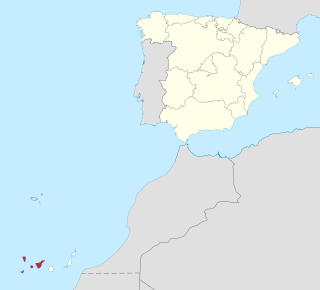
Province of Tenerife, also Province of Santa Cruz de Tenerife, is a province of Spain, consisting of the western part of the autonomous community of the Canary Islands. It consists of about half of the Atlantic archipelago: the islands of Tenerife, La Gomera, El Hierro, and La Palma. It occupies an area of 3,381 km². It also includes a series of adjacent roques.

Guanches were the aboriginal inhabitants of the Canary Islands. In 2017, the first genome-wide data from the Guanches confirmed a North African origin and that they were genetically most similar to modern North African Berber peoples of the nearby North African mainland. It is believed that they migrated to the archipelago around 1000 BCE or perhaps earlier.

Tenerife is the largest and most populated island of the seven Canary Islands. It is also the most populated island of Spain, with a land area of 2,034.38 square kilometres (785 sq mi) and 904,713 inhabitants, 43 percent of the total population of the Canary Islands. Tenerife is the largest and most populous island of Macaronesia.

Santa Cruz de Tenerife (commonly abbreviated as Santa Cruz is a major city, capital of the island of Tenerife, Province of Santa Cruz de Tenerife, and capital of the Canary Islands. Santa Cruz has a population of 206,593 within its administrative limits. The urban zone of Santa Cruz extends beyond the city limits with a population of 507,306 and 538,000 within urban area. It is the second largest city in the Canary Islands and the main city on the island of Tenerife, with nearly half of the island's population living in or around it.

Mount Teide is a volcano on Tenerife in the Canary Islands, Spain. Its summit is the highest point in Spain and the highest point above sea level in the islands of the Atlantic.
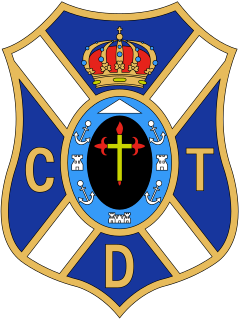
Club Deportivo Tenerife, S.A.D. is a Spanish football club based in Santa Cruz de Tenerife, Tenerife, in the Canary Islands. Founded in 1912, it currently plays in Segunda División, holding home matches at the Estadio Heliodoro Rodríguez López, with a 22,824-seat capacity.

Arico is the name of a municipality and a village in the southeastern part of the island of Tenerife, one of the Canary Islands, Spain. It is part of the Province of Santa Cruz de Tenerife. The municipality is located in the southeastern part of the island, and extends for 178,76 square kilometers from the mountainous interior to the beaches on the Atlantic. Its estimated population is around 7,500. The TF-1 motorway passes through the eastern part of the municipality.

Buenavista del Norte is a municipality and town on the north coast of Tenerife. It is located on the TF42 Road, about 75 km west of the capital Santa Cruz de Tenerife, and 65km from Tenerife North Airport.
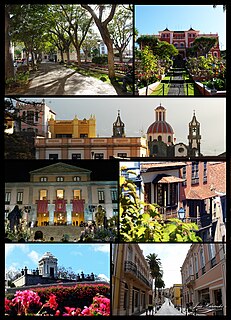
La Orotava is a town and a municipality in the northern part of Tenerife, one of the Canary Islands of Spain. The area of the municipality stretches from the north coast to the mountainous interior, and includes the summit of the Teide volcano, Canary Islands' and Spain's highest point at 3,718 m. At 207.31 km2, it is the largest municipality of the island of Tenerife. The population is 41,255 (2013).

Teide National Park is a national park located in Tenerife.

The TF-1 is a motorway encircling the eastern and the southern parts of the island of Tenerife. The TF-1 motorway runs from the capital Santa Cruz in the north to Adeje with its major tourist resorts Los Cristianos and Playa de las Américas in the south of the island, and continues to Santiago del Teide in the west. It is a 103 km motorway and interchange numbers go facing south. The motorway is one in the Canary Islands that passes through most of the municipalities and is the longest in the archipelago as well.

On the island of Tenerife, in the Canary Islands, a large number of sports are practiced, both outdoors and indoors in the various facilities available throughout the island.

The Auditorio de Tenerife "Adán Martín" is an auditorium in Santa Cruz de Tenerife, Canary Islands, Spain. Designed by architect Santiago Calatrava, it is located on the Avenue of the Constitution in the Canarian capital, and next to the Atlantic Ocean in the southern part of Port of Santa Cruz de Tenerife. Construction began in 1997 and was completed in 2003. The auditorium was inaugurated on 26 September of that year in the presence of Felipe de Borbón, Prince of Asturias, and was later visited by former U.S. President Bill Clinton. The building is framed within the tenets of late-modern architecture of the late 20th century.
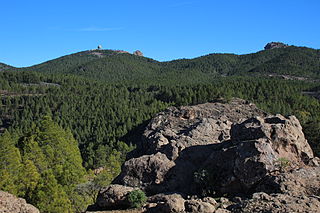
Pico de las Nieves is the highest peak of Gran Canaria Canary Islands, Spain. Its height is 1,949 metres (6,394 ft) above sea level. The origin is volcanic (stratovolcano). On its slopes, Canary Islands Pine was reintroduced in the 1950s.

Mount Teneriffe in central Victoria, Australia, is a distinctive granite formation, 444 m (1,457 ft) above sea level. It takes its name from the island of Tenerife in Spain.
Alfredo Merino Tamayo is a Spanish retired footballer, and a current manager.
Enrique 'Quique' Juan Medina Rodríguez is a Spanish retired footballer who played as a defender, and a current coach.
Cerro Tenerife is a mountain located next to the small town of Puerto Natales and Torres del Paine National Park in Chilean Patagonia.
